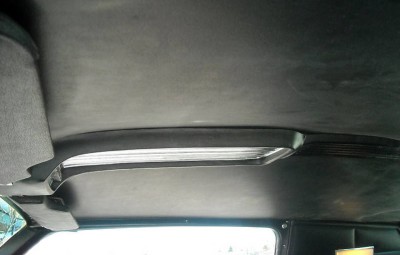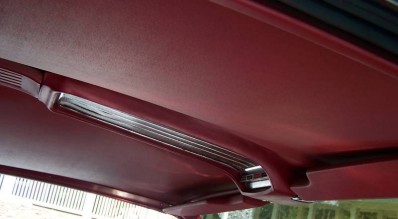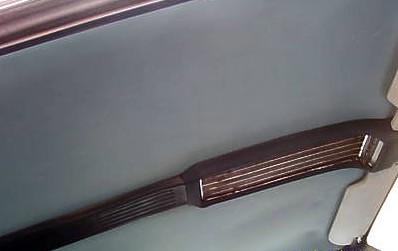1966-1967 Ford Thunderbird
|
|
Ford moved the interior focal point overhead |
|
|
In the third and final year of the body style introduced for 1964, Ford designers and stylists gave the 1966 Thunderbird a heavier than normal restyle. As was expected in the third year, more extensive revisions would be made in an attempt to attract attention to an aging design. The third year restyle had been done before in 1957, 1960, and 1963. For 1966, a fresh appearance would be even more important, as new competition would be challenging the Thunderbird for sales, and that would come in the form of the 1966 Oldsmobile Toronado, a sleek front wheel drive car that became Motor Trend's Car of the Year. For the exterior, all new sheet metal from the windshield forward was introduced, including a new blade-type front bumper that was more than just a little bit reminiscent of the one found on the popular Ford Mustang. For the first time ever on the T-bird, body colored sheet metal would appear below the front bumper, and the hood scoop would be lower than ever before as well. Full width tail lamps set the Bird's rear end ablaze in light, and a new, more formal "Town" roof line was introduced for the first time. This was accomplished by bringing the rear roof quarter panel forward to meet the front door glass, which eliminated the side windows. The gently rounded upper rear corner also appeared to have been inspired by the Mustang Fastback model, although the roof line itself wasn't as sporting. Two new models were offered for 1966: the Town Hardtop and Town Landau. There was a Hardtop also, as there had been since 1958, but it was called the "Conventional Hardtop" in some literature; the traditional Landau model didn't exist for 1966, only the Town Landau was offered. Ford wanted something unique for the interior, especially for the roof of the car. It wanted to call special attention to the interior roof of hardtop models, perhaps in part due to the fact that 1966 would be the final year for the Thunderbird Convertible, and a new feature for the hardtops might help them to stand out a bit.
The front section of the roof console was wider than the rear section, and included a row of four red warning lights to alert driver and passengers when a door was ajar, fuel was low, or the emergency flashers were operating. Another light served as a reminder for all to fasten their seat belts. The door ajar light specified a special bulb that would flash after about 10-20 seconds, calling attention to the door ajar situation. The flasher light also served as a switch, which when pressed, would activate or turn off the flashers. A textured black vinyl or simulated wood grain insert decorated the front section of the console, dependant upon model (hardtops utilized the black vinyl, Landaus the wood grain.) The finished appearance was certainly unique, and offered a reason for Thunderbird's customers to look up, even if it wasn't to see the moon and stars above. This worked just great until about 1972, when the glue began to give way to gravity, allowing the vinyl material to sag. Replacements were still available through special order at Ford dealers, but many of them were coming unglued as well, even though they'd been stored indoors in boxes. Attempts to re-glue the original vinyl material were usually short lived, as the foam would no longer stick to the cardboard material. Needless to say, many unique ways of solving this problem have been seen over the years: everything from adding decorative buttons to hold the material up to sewing the material to the cardboard in a decorative pattern. Some, obviously, were done better than others, but none looked as clean as the original glued design. One of the best auto trim shop repairs mimicked the molded, ribbed vinyl pattern on the rear section of the roof console, which was no doubt one of the more expensive options, but honestly looked pretty good. While the sun visors always matched the headliner material, the roof console sometimes did not. And as with so many of these cars, exceptions to the rule can be found fairly easily. For instance, Thunderbirds with dark blue interiors often had medium blue vinyl material on the headliner boards with matching sun visors, and a dark blue roof console. That is, on cars built before sometime around December 1, 1965. After this date, the headliner vinyl and visors became a lighter blue, causing a little confusion because the change over date wasn't necessarily correct. Automotive Mileposts has documented a Town Landau with a November 17, 1965 build date which had the lighter blue headliner. Chances are this car was built later than scheduled, but other exceptions to this rule apply as well.
Fewer two tone headliner-roof console color combinations were seen in 1967, although cars with the dark blue interiors still used a lighter shade of blue for the headliner and sun visors, with dark blue roof console pieces. This was true on the new Fordor Landau models as well, although the roof console on that model was a different design and always matched the headliner color. The 1967 Fordor Landau models introduced a contoured roof console that stretched from side to side above the windshield on Birds equipped with the optional Convenience Check Group. It would have recessed areas for the sun visors and four small round reminder lights at its center. on the Fordor models and on everything built from 1968 on, the roof console always matched the headliner color. As we mentioned earlier, the 1966 Town Landau models featured a simulated wood grain insert on the forward section of the roof console, and a textured black insert on Town Hardtop models. In 1967, the Hardtop received a brushed aluminum panel on the front and rear sections, with simulated wood grain in those areas on the Landau. 1967 would be the last time Ford would use a contoured headliner on the T-bird during the classic era. Here are some of the details: 1966 ThunderbirdModels:
Now here's where it gets a bit confusing...in addition to the exceptions mentioned above, Thunderbirds with both Aqua and Silver Mink interiors have also been documented with light blue headliners that contrasted the dominant interior color. Cars with Red interiors have been documented with both red headliner, red sun visors, and red roof console as well as white headliner, white sun visors and red roof console. In all cases, the roof consoles have always matched the seat color. Reports of new cars being delivered with one side white and the other side parchment, have also been noted. It's pretty obvious that there was a bit of confusion as to what color to use at the factory, and if it seemed like it would be a nice contrast, or a match, it was used. Perhaps a shortage of a particular color required a substitute color be used to keep the assembly line moving. We'll likely never know for certain, but there are some inconsistencies. 1967 ThunderbirdModels:: REMOVAL AND INSTALLATION: REPAIR OF CONTOURED HEADLINER BOARDS: |
|


 Note: The molded headliner panel, sun visors, and roof console matched the predominant
interior color for 1966, except for a few instances. All Dark Blue interior
trim codes featured a lighter shade of blue on the headliner panel and
sun visors (shown at left). In the image, pay attention to the mismatch
of shades between the light blue sun visors and the medium blue headliner
panels. Two different shades of blue were used, depending on the build
date. Early cars (prior to 12-1-65) used a medium shade of blue, later
cars used a lighter blue. As mentioned previously, AM has documented one
1966 Thunderbird Town Landau with a build date of November 17, 1965 that
left the factory with the lighter blue headliner and visors, so the change
over date may have actually been earlier than December 1st. Service replacement
headliner panels ordered in 1973 were shipped out in the medium blue shade,
which caused a mismatch with the sun visors on cars with a later build
date using the lighter shade of blue. In 1966, Emberglo interiors always
featured a Parchment colored headliner and sun visors with a contrasting
Emberglo roof console assembly.
Note: The molded headliner panel, sun visors, and roof console matched the predominant
interior color for 1966, except for a few instances. All Dark Blue interior
trim codes featured a lighter shade of blue on the headliner panel and
sun visors (shown at left). In the image, pay attention to the mismatch
of shades between the light blue sun visors and the medium blue headliner
panels. Two different shades of blue were used, depending on the build
date. Early cars (prior to 12-1-65) used a medium shade of blue, later
cars used a lighter blue. As mentioned previously, AM has documented one
1966 Thunderbird Town Landau with a build date of November 17, 1965 that
left the factory with the lighter blue headliner and visors, so the change
over date may have actually been earlier than December 1st. Service replacement
headliner panels ordered in 1973 were shipped out in the medium blue shade,
which caused a mismatch with the sun visors on cars with a later build
date using the lighter shade of blue. In 1966, Emberglo interiors always
featured a Parchment colored headliner and sun visors with a contrasting
Emberglo roof console assembly.